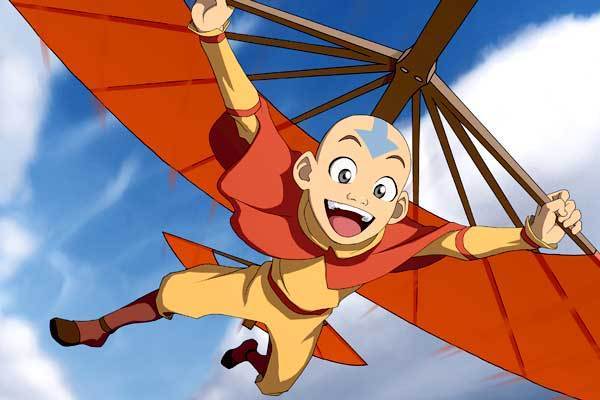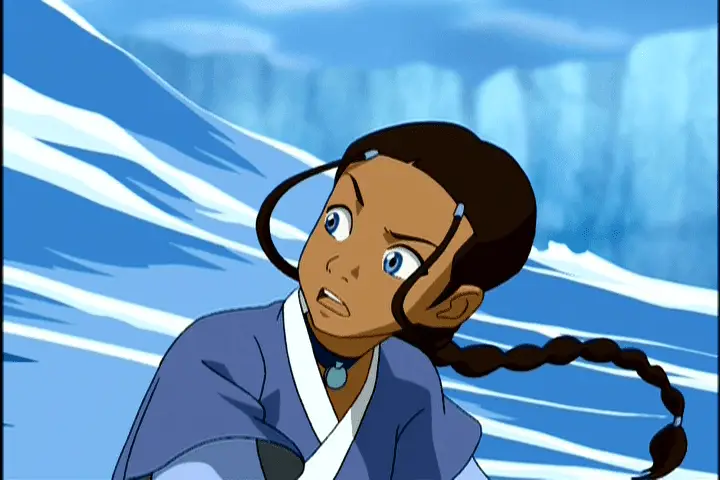A few key character journeys in the Avatarverse have resonated strongly with many viewers in the LGBTQ community. Avatar: The Last Airbender may not necessarily include the same open representation that the The Legend of Korra finale presented I us; but as I hope to unpack in this series, there is much to the story that may well resonate with some viewers in similar (albeit more subtle) ways. After all, Aang is as much Korra’s past as Korra is Aang’s future, since the Avatar Spirit deeply connects all the incarnations of the Avatar.
This entry will take a look at the introductions to Aang and Katara, and the significance of their immediate romantic connection. Or, shall we say, Aang’s wildly instantaneous crush.
Aang

Aang isn’t a queer character like Korra (at least, not explicitly in the text. But headcanon all you like!) . But like Korra, Aang is undoubtedly different from everyone around him. ATLA introduces us to Aang right when he is at the height of discovering these differences for himself.
“He’s special, I can tell.” — Katara
Aang’s people, the air nomads, were wiped out in a genocidal attack by the Fire Nation. The grief of his lost history is something that he will carry for the rest of his life. The discovery of this loss is full of all kinds of pain, but most notable is the pain of alienation. Not only is Aang the only Avatar, he is now the only air nomad, stripped of a familial and cultural surrounding. When Aang first wakes in ATLA’s opening episode, he finds himself in a world he’s only read and heard about. The childish side of Aang comes to his rescue, burying the confusion of his displacement with a fiery curiosity about Katara and penguin sledding.
Beneath his joy over risky play, Aang is hiding a big secret. He’s the Avatar, the one that everyone needs and is looking for. Aang’s fear of the burden of this part of his identity, as well as possible fears about his and the Water Tribe’s safety, are what prevent him from revealing his true self to Katara and Sokka. When he finally does explain, it’s with reluctance. He never asked to be the Avatar, and he isn’t sure he wants to be. For a young kid like Aang, whose knowledge of the Avatar Spirit was revealed to him prematurely, it’s an understandable reaction. With an identity as starkly differential as Aang’s it’s somewhat comparable to coming out.
Katara

If Aang is something of a closeted kid, Katara is the out and proud one. The only bender in her entire village (although let’s be real, it’s a tiny village), Katara is thrilled to discover another bender like herself. She now has someone who can teach her how to control her water bending powers, and she’ll gladly help Aang if he can help her
Katara is bold, and that’s what makes her such a strong character. Most famous for being the first character on a kids’ show to use the word “sexist”, and in the first episode no less, Katara has never been afraid to say what she thinks. Her stark honesty is a welcome characteristic to compliment Aang’s cheerful openness.
The Connection
The most significant thing about the setup of Aang and Katara is the immediate hint of romance. The writers manage to bring up a myriad of difficult themes and subverted tropes in Aang and Katara’s characters. By using the cliche of an adorkable tween hetero romance that we’re pretty used to seeing in mainstream television, the writers free themselves up to flip the script a million other ways. It’s played with from the very start, as the camera and pacing teases that Aang’s first words after waking will be “Will you go out with me?” or something similar, but instead he invites Katara to join him on his infamous quest to go penguin sledding.
Aang and Katara manage to contrast in a fantastically beautifully number of ways. Where Katara is mature and thoughtful, Aang is fearless and spontaneous. Both manage to become the support the other needs and teach the other to let go of fear and embrace their strengths. Their initial connection of friendship is sparked by the sameness they discover in their similar statuses as outsiders.
Aang and Katara each also have privilege in contrasting areas. Katara has a wider support system of family and cultural tradition (Aang has cultural tradition too but his lack of guidance is a devastating loss as we’ve covered). Aang has much more power and influence, as evidenced by his knowledge of bending and ability to attract a pretty major fan base on Kyoshi Island. They both have to come to an understanding that while they’ve have similarities, their differences must be acknowledged and worked through. In time we’ll discuss how they get there.

